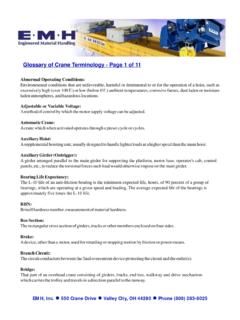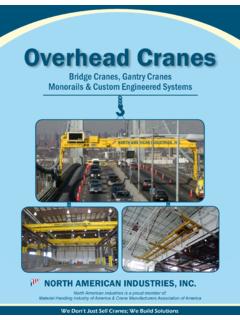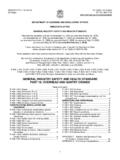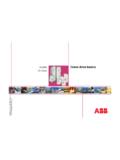Transcription of GI Part 18. Overhead and Gantry Cranes As of February 2018 ...
1 GI Part 18. Overhead and Gantry Cranes Compared With 29 Overhead and Gantry Cranes As of February 2018 Summary: The significant differences between GI Part 18. Overhead and Gantry Cranes and 29 Overhead and Gantry Cranes are in: Employer responsibilities Certification; modification; guards; adoption of standards by reference Marking rated capacity; classifications; clearances Safety factor for hoisting cables Wire ropes Hooks; load blocks Brakes and restraints Controls Limitations on use of Cranes Reporting defects General conduct of operators Signals Lifting Inspections The comparisons show only those provisions where MIOSHA rules are different than OSHA or where MIOSHA rules are not included in 29 **means there is a comparable OSHA rule to this paragraph MIOSHA OSHA R Employer responsibilities.
2 Rule 1808. (1) An employer shall comply with the manufacturer s specifications and limitations applicable to the operation of Cranes . If a manufacturer s specifications are not available, then the limitations assigned to the equipment shall be based on the determination of a qualified engineer who is competent in the field of equipment limitations, and the determination shall be appropriately documented and recorded. Attachments that are used with Cranes shall not exceed the capacity, rating, or scope recommended by the manufacturer. (2) An employer shall designate a qualified person to perform all inspections of Cranes as required by this No comparable OSHA provisions Page 2 of 12 MIOSHA OSHA (3) An employer shall limit the use of a crane to the following entities: (a) An employee who has been trained and qualified to operate the type of crane to which he or she is assigned.
3 (b) A learner who is under the direct supervision of a designated operator. (c) Designated maintenance personnel while performing their duties. (4) An employer shall maintain a crane and its accessories in a condition that will not endanger an operator or other employees (5) The original safety factor of the equipment shall not be reduced if modifications or changes are made to the equipment. Modifications or changes shall be certified by a qualified registered engineer. The capacity, operation, and maintenance instruction plates, tags, or decals shall be changed accordingly to reflect any modifications or changes. (6) An employer shall comply with all other applicable requirements of this standard. (7) The manual provided by the crane manufacturer shall be readily accessible for the crane operator s reference at the work site.
4 No comparable OSHA provisions, except for: (b)(8) Designated personnel. Only designated personnel shall be permitted to operate a crane covered by this section. CONSTRUCTION, INSTALLATION AND EQUIPMENT Certification; modification; guards; adoption of standards by reference. Rule 1821. (1) A top running or Gantry crane consisting of a top running bridge with single or multiple girders and a top running trolley hoist, erected or modified after June 24, 1973 and before April 9, 2002, shall be certified by a crane manufacturer or an engineer knowledgeable in crane construction, that the new construction or installation, or modification conforms to the ANSI/ASME " Overhead and Gantry Cranes ," Standard, 1967 edition, as adopted in R (2) A top running or Gantry crane consisting of a top running bridge with single or multiple girders and a top running trolley hoist, erected or modified after April 9, 2002, shall be certified by a crane manufacturer or an engineer knowledgeable in crane construction, that the new construction or installation, or modification conforms to the ANSI/ASME " Overhead and Gantry Cranes (Top running bridge , single or Multiple Girder, Top running Trolley Hoist)," Standard, 1996 edition, as adopted in R (3)
5 A top running or Gantry crane consisting of a top running bridge with a single girder and an underhung hoist, erected or modified after August 31, 1971 and before April 9, 2002, shall be certified by a crane manufacturer or an engineer knowledgeable in crane construction, that the new construction, installation, or modification conforms to the ANSI/ASME " Overhead and Gantry Cranes ," 1967 edition, as adopted in R No comparable OSHA provision except: (b)(2) New and existing equipment. All new Overhead and Gantry Cranes constructed and installed on or after August 31, 1971, shall meet the design specifications of the American National Standard Safety Code for Overhead and Gantry Cranes , ANSI , which is incorporated by reference as specified in Sec. (b)(3) Modifications.
6 Cranes may be modified and rerated provided such modifications and the supporting structure are checked thoroughly for the new rated load by a qualified engineer or the equipment manufacturer. The crane shall be tested in accordance with paragraph (k) (2) of this section. New rated load shall be displayed in accordance with subparagraph (5) of this paragraph. Page 3 of 12 MIOSHA OSHA (4) A top running or Gantry crane consisting of a top running bridge with a single girder and an underhung hoist, erected or modified after April 9, 2002, shall be certified by a crane manufacturer or an engineer knowledgeable in crane construction, that the new construction, installation, or modification conforms to the ANSI/ASME " Overhead and Gantry Cranes (Top running bridge , single Girder, Underhung Hoist)" Standard, 1998 edition, as adopted in R (5) Gears, couplings and other means of power transmission, except shafts, where exposed to contact, shall be guarded as prescribed in General Industry Safety Standard Part 7 "Guards for Power Transmission," as referenced in R (6)
7 A top running or Gantry crane consisting of a top running bridge with single or multiple girders and a top running trolley hoist may be modified or rerated if the modifications and the supporting structure are checked thoroughly by a qualified engineer or the equipment manufacturer and conform to the ANSI/ASME " Overhead and Gantry Cranes (Top running bridge , single or Multiple Girder, Top running Trolley Hoist)," Standard, 1996 edition, as adopted in R (7) A top running or Gantry crane consisting of a top running bridge with a single girder and an underhung hoist may be modified or rerated if the modifications and the supporting structure are checked thoroughly by a qualified engineer or the equipment manufacturer and conform to the ANSI/ASME " Overhead and Gantry Cranes (Top running bridge , single Girder, Underhung Hoist)" Standard, 1998 edition, as adopted in R No comparable OSHA provision exceptions continued.
8 R Marking rated capacity; classifications; clearances. Rule 1822. (1) The rated capacity of a crane shall be legibly marked on each side of the crane . Markings shall be legible from the ground or floor. Each load block of the hoisting units of the crane shall be legibly marked with its individual rated capacity. (2) Each crane designed and manufactured after January 1, 1971 shall have a service class rating as prescribed in CMAA #70--Specifications for Top running bridge and Gantry Type Multiple Girder Electric Overhead Traveling Cranes , 1970 edition, as shown in Appendix B. Additionally the service class rating shall be legibly marked on each crane . (3) Clearance from obstructions shall be a minimum of 3 inches Overhead and 2 inches laterally between the crane and any obstruction.
9 (4) Runways of parallel Cranes that do not have an intervening wall or structure shall have adequate clearance between the 2 bridges. (5) The cab of a crane shall be located to afford a minimum of 3 inches clearance from all fixed structures within its area of possible movement. No comparable OSHA provision except: (b)(5) Rated load marking. The rated load of the crane shall be plainly marked on each side of the crane , and if the crane has more than one hoisting unit, each hoist shall have its rated load marked on it or its load block and this marking shall be clearly legible from the ground or floor Page 4 of 12 MIOSHA OSHA R Safety factor for hoisting cables. Rule 1823. The designed safety factor for the hoisting cable is as follows: (a) A hot metal crane shall not be less than 8.
10 (b) Any other crane shall not be less than 5. No comparable OSHA provisions R Wire rope. Rule 1824. (1) A wire rope used on a crane shall be repaired or replaced in any of the following circumstances: (a) One third or more of the original diameter of the outside individual wires is worn. (b) There is kinking, crushing, bird-caging, or any other damage that results in distortion of the running portion of the wire rope structure. (c) The wire rope shows heat or corrosive damage. (d) In running ropes, there are 6 randomly distributed broken wires in 1 lay or 3 broken wires on 1 strand in 1 lay. In rotation-resistant ropes, 2 randomly distributed broken wires in 6 rope diameters or 4 randomly distributed broken wires in 30 rope diameters. (e) There are reductions from nominal diameter of more than the following: (i) One sixty-forth of an inch for a diameter to and including 5/16 of an inch.
















